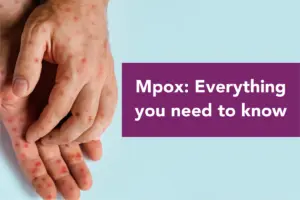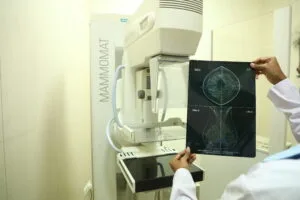MPox: Everything you need to know
What is Mpox?
Mpox is an illness caused by the monkeypox virus, which is a type of viral infection. It primarily spreads between people through close contact and, less commonly, from surfaces or objects that have been touched by someone with mpox. In areas where the monkeypox virus is found in wild animals, it can also be transmitted to humans who come into contact with these infected animals.
Mpox symptoms:
Symptoms of mpox often feature a rash that can develop on different areas of the body, including the hands, feet, chest, face, mouth, or around the genitals. The incubation period for mpox ranges from 3 to 17 days, during which individuals may not exhibit any symptoms and may feel well.
The rash progresses through several stages, eventually forming scabs before healing. It might begin with pimples or blisters, which can be either painful or itchy.
Additional symptoms of mpox can include:
– Fever
– Chills
– Swollen lymph nodes
– Fatigue
– Muscle and back pain
– Headache
– Scratchy throat, stuffy nose, or persistent cough.
Diagnosis of Mpox:
Diagnosing mpox can be challenging due to its similarity to other infections and conditions. Accurate differentiation from chickenpox, measles, bacterial skin infections, scabies, herpes, syphilis, other sexually transmitted infections, and medication-related allergies is essential. For example, individuals with mpox might also have a coexisting sexually transmitted infection, such as herpes, while children with suspected mpox could simultaneously exhibit symptoms of chickenpox. Effective diagnosis is critical for timely treatment and controlling the spread of the virus.
The preferred diagnostic approach for mpox involves detecting viral DNA using polymerase chain reaction (PCR). Optimal specimens for testing are directly obtained from the rash—such as skin, fluid, or scabs—through vigorous swabbing. In cases where skin lesions are absent, oropharyngeal, anal, or rectal swabs can be used.
Tests done to detect Mpox:
Currently, mpox is diagnosed using a laboratory-based polymerase chain reaction (PCR) technique, which is a standard method for identifying various infections. At present, PCR tests remain the only recommended approach for diagnosing mpox.
As per government directives, currently these tests are available at designated Nodal laboratories (Kasturba hospital, Mumbai) and Central laboratory (NIV, Pune).
Rapid tests are in development to detect viral antigens (proteins associated with the virus). However, their effectiveness, including the ease of detection, appropriate sample types, and the timing of detection during the infection, is not yet fully established. Consequently, the accuracy of these rapid antigen tests is uncertain, and they should not be used for diagnosing active mpox infections at this time. Ongoing research aims to determine the reliability and applicability of these tests.
Antibody tests, also known as serological tests, can detect the immune response following infection with the monkeypox virus. These tests indicate past exposure rather than active infection and are not recommended as the sole method for diagnosing mpox. Antibody tests are primarily used for research purposes and are not widely available.
How does Mpox spread?
Mpox spreads through several primary routes:
1. Direct Contact: The virus can be transmitted through direct physical contact with the rash or sores of an infected person. This includes touching, hugging, or sexual contact where there is skin-to-skin contact.
2. Indirect Contact: Indirect transmission can occur through contact with contaminated objects or surfaces, such as bedding, clothing, or utensils, that have been used by an individual with mpox.
3. Respiratory Droplets: The virus can spread through respiratory droplets during prolonged face-to-face contact with an infected person. This is less common but possible, especially in close living conditions.
4. Animal Contact: In regions where the monkeypox virus is present in wildlife, it can be transmitted from infected animals to humans through contact with the animals or their bodily fluids.
Who is at risk of Mpox?
Individuals who have close contact with someone infected with mpox are at increased risk of contracting the virus. Close contact includes skin-to-skin interactions (such as touching or sexual activity), as well as mouth-to-mouth or mouth-to-skin contact (such as kissing). Additionally, being face-to-face with an infected person, where respiratory particles may be exchanged, can also pose a risk.
Transmission can occur through contact with contaminated clothing, bedding, towels, objects, electronics, and other surfaces that have been touched by an infected person.
Those living with someone diagnosed with mpox should take precautions to minimize their risk of infection. The infected individual should be evaluated by a healthcare provider to determine if they can safely be cared for at home and if home isolation is feasible.
Healthcare workers caring for patients with mpox should adhere to stringent infection prevention and control protocols. This includes using appropriate personal protective equipment (PPE), following established procedures for safely collecting diagnostic specimens from lesions, and handling sharps like needles according to safety guidelines.
What are the risks of mpox during pregnancy?
Contracting mpox during pregnancy poses significant risks, as pregnancy is considered a state of relative immunosuppression. The virus can lead to serious complications, including pregnancy loss, stillbirth, neonatal death, or health issues for the parent. Pregnant individuals should avoid close contact with anyone infected with mpox to mitigate these risks. If you suspect exposure to or symptoms of mpox, it is essential to consult your healthcare provider. They can help with testing and make sure you get the right care.
How can I protect myself from mpox virus?
To safeguard yourself and others against mpox, it’s essential to be informed about the signs and symptoms of the virus, its modes of transmission, and appropriate actions if you become ill. Additionally, understanding the prevalence of the virus in your area or community is crucial.
If mpox is circulating in your community, maintain open communication with close contacts about any symptoms you or they might be experiencing. Avoid close contact, including sexual contact, with individuals showing symptoms of mpox. Practice frequent hand hygiene using soap and water or an alcohol-based hand sanitizer.
If you suspect you have mpox, seek medical advice promptly and isolate yourself from others until you have been evaluated and tested. During isolation, remain separate from others until all lesions have crusted over, scabs have fallen off, and new skin has formed underneath. Adhere to local health authority guidelines regarding isolation, whether at home or in a health facility. Additionally, if you are sexually active, use condoms for up to 12 weeks
Treatment for Mpox:
Management of mpox primarily focuses on symptom relief. This typically involves addressing skin damage from the rash, maintaining adequate fluid intake to prevent constipation, and managing pain. Individuals with mpox should isolate themselves at home in a separate room from family and pets until the rash and scabs are fully healed.
Currently, there is no specific treatment approved exclusively for mpox. Healthcare providers may consider using antiviral medications, such as tecovirimat (TPOXX) or brincidofovir (Tembexa), which are also employed in the treatment of smallpox. For patients who are unlikely to benefit from vaccination, healthcare professionals might recommend administering vaccinia immune globulin. This treatment contains antibodies derived from individuals who have received the smallpox vaccine.


